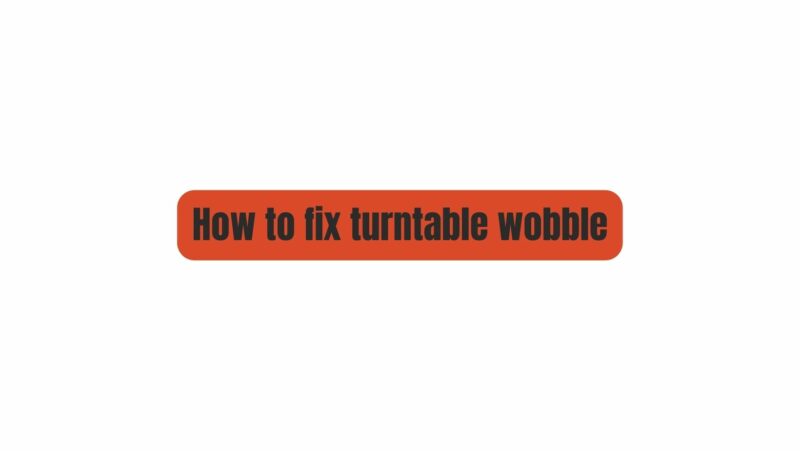The allure of vinyl records lies not just in their warm, analog sound but also in the tactile engagement they offer. The ritual of placing a record on a turntable and watching it spin can be both meditative and mesmerizing. However, that experience can be marred when you encounter a common issue: turntable wobble. A wobbling turntable can affect sound quality, cause playback issues, and even damage your precious vinyl. In this comprehensive guide, we will explore the reasons behind turntable wobble, step-by-step instructions to diagnose the problem, and practical solutions to fix it, ensuring that your vinyl listening experience remains smooth and enjoyable.
Understanding Turntable Wobble: Causes and Consequences
Turntable wobble, also known as turntable speed fluctuation or wow and flutter, refers to the irregular rotation of the turntable platter. This issue can manifest as slight speed variations or more pronounced wobbling, and it can have several causes:
- Belt Drive Turntables: Belt-driven turntables use an elastic belt to connect the motor to the platter. Over time, these belts can stretch, wear out, or become misaligned, leading to speed inconsistencies and wobbling.
- Direct Drive Turntables: Even direct drive turntables, which have the motor directly connected to the platter, can experience wobble due to motor issues, bearing problems, or damaged platter components.
- Uneven Surface: Placing your turntable on an uneven or unstable surface can lead to wobbling. It’s crucial to ensure that your turntable is on a level, stable platform.
- Platter Imbalance: If the platter or the record itself is not balanced correctly, it can cause wobbling during playback.
- Dust and Debris: Accumulated dust and debris on the turntable’s components, such as the platter or the motor, can lead to irregularities in rotation speed.
Diagnosing Turntable Wobble: Step-by-Step Guide
Before you can fix turntable wobble, you need to identify its root cause. Follow these steps to diagnose the issue:
- Visual Inspection:
- Examine the turntable’s placement: Ensure it is on a stable, level surface.
- Check for any visible damage to the platter or the record.
- Inspect the tonearm for any obstructions or misalignments.
- Belt Examination (For Belt Drive Turntables):
- Carefully remove the platter to access the belt.
- Check the belt for signs of wear, stretching, or misalignment.
- Ensure that the belt is correctly positioned on both the motor and the platter pulleys.
- Platter Balance Check:
- If your turntable has an adjustable tonearm counterweight, make sure it is correctly calibrated according to the manufacturer’s instructions.
- Check for any loose or unevenly distributed weight on the platter.
- Motor and Bearing Inspection:
- Inspect the motor and bearings for any visible damage or irregularities.
- Look for any foreign objects or debris that may be interfering with their operation.
- Dust and Debris Removal:
- Clean the turntable thoroughly, paying special attention to the platter and motor components.
- Use a soft brush or microfiber cloth to remove dust and debris.
- Test Playback:
- Place a record on the turntable and play it.
- Listen for speed variations or fluctuations in sound quality.
- Observe the platter for wobbling during playback.
Fixing Turntable Wobble: Solutions and Troubleshooting
Once you have identified the cause of turntable wobble, you can proceed with the appropriate solution:
- Belt Replacement (For Belt Drive Turntables):
- If the belt is worn, stretched, or misaligned, replace it with a new one following the manufacturer’s recommendations.
- Ensure proper belt tension and alignment.
- Direct Drive Motor Repair (For Direct Drive Turntables):
- If the motor is causing wobble, it may require servicing or replacement by a professional technician.
- Address any bearing issues promptly.
- Platter Balance Adjustment:
- If the platter is imbalanced, remove the platter and make the necessary adjustments to ensure it is evenly weighted.
- Check for and remove any obstructions or foreign objects on the platter.
- Tonearm Alignment:
- If the tonearm is misaligned, use a protractor or alignment tool to calibrate it correctly.
- Ensure that the tonearm is balanced and set to the appropriate tracking force for your cartridge.
- Stable Surface:
- If the turntable is on an uneven or unstable surface, relocate it to a level, solid platform.
- Isolation platforms or shelves can further reduce vibration and wobble.
- Regular Maintenance:
- Make cleaning and maintenance of your turntable a routine practice to prevent dust and debris buildup.
- Professional Servicing:
- If you are unable to diagnose or fix the issue yourself, consider seeking the assistance of a professional turntable technician or repair service.
Preventing Turntable Wobble: Maintenance Tips
Prevention is often the best strategy when it comes to turntable wobble. Here are some maintenance tips to keep your turntable running smoothly:
- Regular Cleaning: Clean your turntable, platter, and tonearm regularly to prevent dust and debris buildup.
- Correct Storage: When not in use, protect your turntable and records from environmental factors that can affect performance, such as temperature fluctuations and humidity.
- Proper Handling: Handle your records with care, and always use a dust cover when the turntable is not in use.
- Stable Setup: Ensure your turntable is placed on a stable, level surface to minimize the risk of wobbling.
- Belt Replacement: For belt drive turntables, replace the belt periodically as recommended by the manufacturer.
- Professional Calibration: Consider having your turntable professionally calibrated and serviced regularly to maintain optimal performance.
Conclusion
A wobbling turntable can be a frustrating obstacle to enjoying your vinyl records to the fullest. However, armed with the knowledge of potential causes and solutions, you can diagnose and address turntable wobble effectively. Remember that regular maintenance, correct setup, and careful handling are key to preventing wobble and ensuring that your vinyl listening experience remains smooth, enjoyable, and faithful to the analog charm that vinyl records provide.

